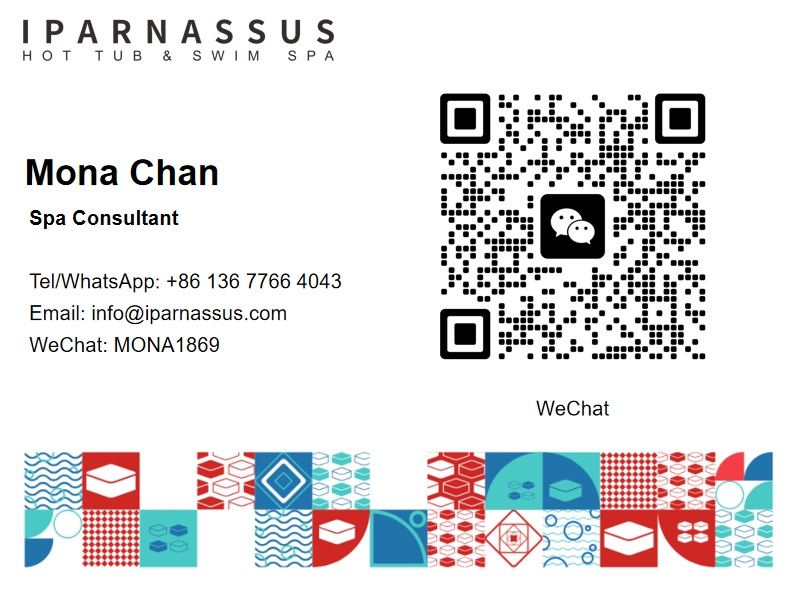Are Chemicals Making My Hot Tub Foamy?
2024-10-24 15:32:21
If you've ever stepped into your backyard swim spa or hot tub only to find it filled with an excessive amount of foam, you might be wondering about the cause. While a small amount of foam is normal, excessive foaming can be a sign of chemical imbalance or other issues. In this blog post, we'll explore the relationship between chemicals and foam in your hot tub, as well as address some common questions about backyard swim spas.
How do I reduce foam in my swim spa?
Foam in your swim spa can be unsightly and may indicate underlying problems with water chemistry or maintenance. Here are some effective ways to reduce foam in your swim spa:
1. Check and balance water chemistry: The first step in reducing foam is to ensure your water chemistry is balanced. Test the pH, alkalinity, and sanitizer levels regularly. Ideally, maintain a pH between 7.2 and 7.8, and total alkalinity between 80 and 120 ppm. Proper chemical balance helps prevent foam formation.
2. Use a defoamer: Specialized defoaming products are available for swim spas and hot tubs. These products break down the foam quickly but should be used sparingly as they only treat the symptom, not the underlying cause.
3. Clean or replace filters: Dirty filters can contribute to foam buildup. Clean your filters regularly according to the manufacturer's instructions or replace them if they're worn out.
4. Shower before use: Encourage all users to shower before entering the swim spa. This removes body oils, cosmetics, and other substances that can cause foaming.
5. Avoid using soap or detergents near the spa: Ensure that no soap, shampoo, or detergents are used in or around the swim spa, as these are common causes of foaming.
6. Drain and refill regularly: Over time, dissolved solids build up in the water, making it more prone to foaming. Drain and refill your swim spa every 3-4 months, or more frequently with heavy use.
By implementing these strategies, you can significantly reduce foam in your swim spa and enjoy a cleaner, more pleasant swimming experience. Remember, consistent maintenance is key to preventing foam buildup and other water quality issues.
What causes excessive foam in a hot tub?
Excessive foam in a hot tub can be frustrating and may indicate underlying issues with your water chemistry or maintenance routine. Understanding the causes can help you prevent and address this problem effectively. Here are the main factors that contribute to excessive foam in hot tubs:
1. High levels of organic contaminants: One of the primary causes of foam is the buildup of organic materials in the water. These can include:
- Body oils and lotions
- Cosmetics and hair products
- Sweat and dead skin cells
- Detergent residue from bathing suits
As these substances accumulate, they create a perfect environment for foam formation, especially when the water is agitated by jets or movement.
2. Imbalanced water chemistry: Proper water balance is crucial for preventing foam. Specific chemical imbalances that can lead to foaming include:
- Low calcium hardness: Soft water is more prone to foaming.
- High pH levels: When pH rises above 7.8, it can contribute to foam formation.
- Low total alkalinity: This can make it difficult to maintain proper pH levels.
3. Improper use of chemicals: Using too much of certain chemicals or using the wrong types of chemicals can cause foaming. For example:
- Overdosing with algaecides
- Using household cleaners instead of hot tub-specific products
- Adding too many clarifiers or enzymes
4. Poor water circulation and filtration: If your hot tub's circulation and filtration systems aren't working efficiently, contaminants can build up more quickly, leading to foam.
5. Low water levels: When the water level in your hot tub is too low, air can be drawn into the pump and jets, creating more bubbles and foam.
6. Biofilm buildup: Biofilm is a slimy layer of bacteria that can form in pipes and on surfaces. As it breaks down, it can contribute to foaming.
7. Food and beverages in the hot tub: Consuming food or drinks in the hot tub can introduce sugars and other substances that promote foam formation.
8. Overuse of fragrances or aromatherapy products: While these can enhance the hot tub experience, excessive use can lead to foaming.
To address excessive foaming, start by testing your water chemistry and adjusting as necessary. Clean your filters thoroughly and consider using a enzyme-based product to break down organic contaminants. If the problem persists, you may need to drain and refill your hot tub, ensuring you're using fresh, clean water.
Regular maintenance is key to preventing foam buildup. This includes:
- Testing and balancing water chemistry at least weekly
- Cleaning filters regularly
- Showering before entering the hot tub
- Avoiding the use of lotions or oils before hot tub use
- Maintaining proper water levels
- Draining and refilling the hot tub every 3-4 months, or more frequently with heavy use
By understanding the causes of excessive foam and implementing proper maintenance practices, you can enjoy a cleaner, more comfortable hot tub experience.
How often should you change the water in a swim spa?
Maintaining clean and healthy water in your swim spa is crucial for both enjoyment and safety. One of the most important aspects of swim spa maintenance is knowing when and how often to change the water. While there's no one-size-fits-all answer, there are general guidelines and factors to consider when determining the optimal frequency for changing your swim spa water.
General recommendations:
Most manufacturers and experts recommend changing the water in a swim spa every 3 to 4 months. However, this can vary depending on several factors:
1. Usage frequency: If your swim spa sees heavy use, you may need to change the water more often. More frequent use means more contaminants are introduced into the water.
2. Number of users: The more people who regularly use the swim spa, the more often you'll need to change the water.
3. Outdoor vs. indoor: Outdoor swim spas may require more frequent water changes due to exposure to environmental factors like leaves, dust, and insects.
4. Water care system: Advanced water care systems, such as those using ozone or UV light, may extend the time between water changes.
5. Water quality: If you're diligent about maintaining proper water chemistry and cleanliness, you may be able to go longer between water changes.
Factors that indicate it's time for a water change:
1. Cloudy or discolored water: If your water remains cloudy or off-color even after balancing chemicals, it's time for a change.
2. Foul odors: Any unpleasant smells coming from the water indicate a need for fresh water.
3. Difficulty maintaining chemical balance: If you're struggling to keep the pH, alkalinity, or sanitizer levels stable, changing the water can help.
4. Excessive foaming: While some foam is normal, excessive foaming that persists despite treatment may signal a need for fresh water.
5. Total Dissolved Solids (TDS) levels: High TDS levels (typically over 1500 ppm) indicate it's time for a water change.
6. Calcification or scale buildup: Visible scale on surfaces or equipment suggests mineral buildup in the water.
Tips for extending time between water changes:
1. Encourage users to shower before entering the swim spa.
2. Use a pre-filter when filling the swim spa to remove impurities from the source water.
3. Maintain proper chemical balance and sanitizer levels.
4. Clean filters regularly and replace them as needed.
5. Use enzyme products weekly to break down organic contaminants.
6. Implement a routine maintenance schedule, including weekly water testing and balancing.
By following these guidelines and paying attention to your swim spa's specific needs, you can ensure clean, safe water for all users. Remember, regular water changes are an essential part of swim spa maintenance and contribute significantly to the longevity of your investment.
Now, let's discuss the product advantages of Shenzhen Iparnassus Intelligent Spas Co., LTD:
Shenzhen Iparnassus Intelligent Spas Co., LTD is a company specializing in vacation hot tubs and infinity pool spas. Their products offer several advantages that address many of the issues discussed above:
1. Advanced Filtration: Their hot tubs are equipped with circulation filtration and disinfection systems, reducing the need for frequent water changes. This can help maintain water quality for longer periods, addressing the concerns about water change frequency.
2. Professional Expertise: With dedicated teams for design, R&D, production, sales, and after-sales service, Iparnassus ensures high-quality products tailored to customer needs. As of 2023, they have obtained over 30 patents, demonstrating their commitment to innovation in the spa industry.
3. Global Reach: The iParnassus® brand covers dozens of countries and regions worldwide, indicating their products' reliability and international appeal.
4. Customization for Hotels: They offer free custom mold-making and free control system upgrades with hotel centralized management systems, making their products ideal for the hospitality industry.
5. Direct Manufacturer Cooperation: By working directly with top manufacturers, Iparnassus can offer competitive pricing to hotels, ensuring value for money.
6. High-Quality Materials: They use North American production materials and standards, ensuring durability and reliability.
7. Comprehensive After-Sales Service: Iparnassus provides reliable after-sales service, crucial for maintaining the longevity and performance of spa products.
8. Global Distribution: Their products are sold to over 20 countries worldwide, indicating international trust and satisfaction with their offerings.
These advantages make Shenzhen Iparnassus Intelligent Spas Co., LTD a strong choice for both individual consumers and businesses in the hospitality industry looking for high-quality, innovative spa solutions. Their focus on advanced filtration systems can help address many of the common issues related to water quality and maintenance discussed in this blog post.
For more information on hot tub installations and our products, please feel free to contact us at info@iparnassus.com.
References:
1. Lowry, S. (2021). Hot Tub Water Care for Beginners. Swim University.
2. Johnson, M. (2022). The Ultimate Guide to Hot Tub Maintenance. Spa Depot.
3. Smith, R. (2023). Understanding and Preventing Hot Tub Foam. Pool and Spa News.
4. Brown, L. (2021). The Science of Water Chemistry in Spas. Aqua Magazine.
5. Thompson, K. (2022). Best Practices for Swim Spa Maintenance. SwimSpas.com.
6. Davis, E. (2023). Eco-Friendly Hot Tub Solutions. Green Living Journal.
7. Wilson, J. (2021). Hot Tub Troubleshooting: Common Problems and Solutions. Hot Tub Owner HQ.
8. Anderson, P. (2022). The Impact of Water Quality on Spa Equipment Longevity. Spa Retailer.
9. Roberts, C. (2023). Innovations in Spa Water Treatment Technologies. Pool & Spa Marketing.
10. Harrison, T. (2021). Commercial Spa Management: Best Practices for Hotels and Resorts. Hospitality Tech Review.



